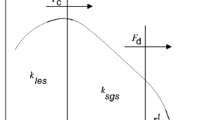Abstract
KEEN waves are non-stationary, nonlinear, self-organized asymptotic states in Vlasov plasmas. They lie outside the precepts of linear theory or perturbative analysis, unlike electron plasma waves or ion acoustic waves. Steady state, nonlinear constructs such as BGK modes also do not apply. The range in velocity that is strongly perturbed by KEEN waves depends on the amplitude and duration of the ponderomotive force generated by two crossing laser beams, for instance, used to drive them. Smaller amplitude drives manage to devolve into multiple highly-localized vorticlets, after the drive is turned off, and may eventually succeed to coalesce into KEEN waves. Fragmentation once the drive stops, and potential eventual remerger, is a hallmark of the weakly driven cases. A fully formed (more strongly driven) KEEN wave has one dominant vortical core. But it also involves fine scale complex dynamics due to shedding and merging of smaller vortical structures with the main one. Shedding and merging of vorticlets are involved in either case, but at different rates and with different relative importance. The narrow velocity range in which one must maintain sufficient resolution in the weakly driven cases, challenges fixed velocity grid numerical schemes. What is needed is the capability of resolving locally in velocity while maintaining a coarse grid outside the highly perturbed region of phase space. We here report on a new Semi-Lagrangian Vlasov-Poisson solver based on conservative non-uniform cubic splines in velocity that tackles this problem head on. An additional feature of our approach is the use of a new high-order time-splitting scheme which allows much longer simulations per computational effort. This is needed for low amplitude runs. There, global coherent structures take a long time to set up, such as KEEN waves, if they do so at all. The new code’s performance is compared to uniform grid simulations and the advantages are quantified. The birth pains associated with weakly driven KEEN waves are captured in these simulations. Canonical KEEN waves with ample drive are also treated using these advanced techniques. They will allow the efficient simulation of KEEN waves in multiple dimensions, which will be tackled next, as well as generalizations to Vlasov-Maxwell codes. These are essential for pursuing the impact of KEEN waves in high energy density plasmas and in inertial confinement fusion applications. More generally, one needs a fully-adaptive grid-in-phase-space method which could handle all small vorticlet dynamics whether pealing off or remerging. Such fully adaptive grids would have to be computed sparsely in order to be viable. This two-velocity grid method is a concrete and fruitful step in that direction.
Similar content being viewed by others
References
B. Afeyan, K. Won, V. Savchenko, T. Johnston, A. Ghizzo, P. Bertrand, Kinetic Electrostatic Electron Nonlinear (KEEN) waves and their interactions driven by the ponderomotive force of crossing laser beams, Proc. IFSA 2003, p. 213 (2003)
D.S. Montgomery, R.J. Focia, H.A. Rose, D.A. Russell, J.A. Cobble, J.C. Fernandez, R.P. Johnson, Phys. Rev. Lett. 87, 5001 (2001)
D.S. Montgomery, J.A. Cobble, J.C. Fernandez, R.J. Focia, R.P. Johnson, R.P. Renard-Le Galloudec, H.A. Rose, D.A. Russell, Phys. Plasmas 9, 2311 (2002)
B. Afeyan, A. Dodhy, M. Mehrenberger, E. Sonnendrücker, Long time evolution of KEEN waves excited with low levels of ponderomotive drive, in preparation
E.M. Lifshitz, L.P. Pitaevski, in Course of Theoretical Physics (Landau-Lifshits) (Pergamon Press, Oxford, 1981), Vol. 10, Translated from the Russian by J.B. Sykes, R.N. Franklin
I. Bernstein, J.M. Greene, M. Kruskal, Phys. Rev. 108, 546 (1957)
M. Shoucri, B. Afeyan, in Stimulated Raman scattering with a relativistic Vlasov-Maxwell code: cascades of nonstationary nonlinear kinetic interactions, Computational and Numerical Simulations, edited by J. Awrejcewicz (InTech Publication, 2014)
J.L. Kline, B. Afeyan, W.A. Bertsche, N.A. Kurnit, D.S. Montgomery, R.P. Johnson, C. Niemann, arXiv:1211.1437 (2012)
F. Casas, N. Crouseilles, E. Faou, M. Mehrenberger, High-order splitting in time for the Vlasov-Poisson equation, in preparation
M. Mehrenberger, C. Steiner, L. Marradi, N. Crouseilles, E. Sonnendrücker, B. Afeyan, ESAIM: Proc. 43, 37 (2013)
Y. Cheng, I.M. Gamba, P.J. Morrison, J. Sci. Comput. 56, 319 (2013)
C. Steiner, M. Mehrenberger, in Proceedings of the International Workshop on the Theory and Applications of Vlasov equation, Nancy, 2013, poster session
C.Z. Cheng, G. Knorr, J. Comput. Phys. 22, 330 (1976)
N. Crouseilles, M. Mehrenberger, E. Sonnendrücker, J. Comput. Phys. 229, 1927 (2010)
M. Brunetti, V. Grandgirard, O. Sauter, J. Vaclavik, L. Villard, Comput. Phys. Commun. 163, 1 (2004)
M. Mehrenberger, N. Crouseilles, E. Sonnendrücker, B. Afeyan, in Proceedings of the Pulsed Power and Plasma Science Conference, San Francisco, 2013, poster
F. Charles, B. Després, M. Mehrenberger, SIAM J. Numer. Anal. 51, 840 (2013)
B. Afeyan, M. Charbonneau-Lefort, K. Won, V. Savchenko, M. Shoucri, The Generation of Self-Organization of Ponderomotively Driven Kinetic Electrostatic Electron Nonlinear (KEEN) Waves in High Energy Density Plasmas, in preparation
D.J. Larson, C.V. Young, A finite mass based method for Vlasov-Poisson simulations, submitted to J. Comput. Phys. (2014)
Author information
Authors and Affiliations
Corresponding author
Additional information
Contribution to the Topical Issue “Theory and Applications of the Vlasov Equation”, edited by Francesco Pegoraro, Francesco Califano, Giovanni Manfredi and Philip J. Morrison.
Rights and permissions
About this article
Cite this article
Afeyan, B., Casas, F., Crouseilles, N. et al. Simulations of kinetic electrostatic electron nonlinear (KEEN) waves with variable velocity resolution grids and high-order time-splitting. Eur. Phys. J. D 68, 295 (2014). https://doi.org/10.1140/epjd/e2014-50212-6
Received:
Revised:
Published:
DOI: https://doi.org/10.1140/epjd/e2014-50212-6



